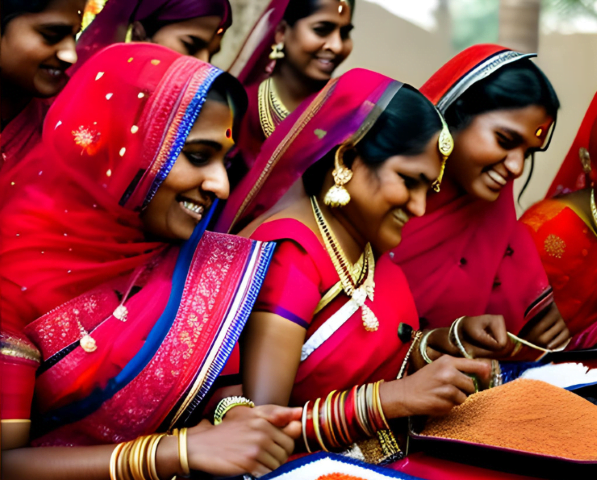Empowering India’s Future: The Journey of Women’s Education
Table of Contents
1. Introduction
2. The Status of Women's Education in India
- Current Scenario
- Challenges Faced
- Government Initiatives
3. The Importance of Women's Education
- Empowerment and Gender Equality
- Social and Economic Development
- Breaking Stereotypes
4. Factors Affecting Women Education
- Cultural and Societal Norms
- Poverty and Lack of Access
- Security and Safety Concerns
5. Initiatives and Programs Promoting Women Education
- Educating the Girl Child
- Scholarships and Financial Support
- Skill Development Programs
6. Success Stories: Inspiring Women Achievers
- Kalpana Chawla
- Mary Kom
- Arundhati Bhattacharya
7. The Way Forward: Overcoming Challenges
- Changing Mindsets
- Enhancing Accessibility
- Strengthening School Infrastructure
- Educating Communities
8. Conclusion
9. FAQs
Women’s Education in India

Introduction
Women’s education in India has long been a topic of discussion and concern. Despite significant progress in various sectors, there are still several hurdles that impede the education of women across the country. Empowering women through education is crucial to achieving gender equality, fostering social development, and breaking the shackles of traditional stereotypes. This article delves into the current state of women’s education in India, the challenges faced, government initiatives, the importance of educating women, factors affecting women’s education, initiatives and programs promoting education, inspiring success stories, and potential solutions to overcome challenges.
The Status of Women’s Education in India
Current Scenario
As India marches towards progress, the status of women’s education has seen improvement over the years. More girls are enrolling in schools, and the gender gap in literacy rates has narrowed down. However, there is still a significant disparity between male and female literacy rates, particularly in rural areas.
Challenges Faced
Several challenges hinder women’s education in India. Cultural and societal norms often prioritize domestic roles for women, leading to early marriage and limited opportunities for education. Poverty and lack of access to schools in remote areas further exacerbate the situation. Additionally, security and safety concerns pose significant obstacles, especially in regions where girls face the risk of harassment and violence during their commute to school.
Government Initiatives
Recognizing the importance of women’s education, the Indian government has implemented various initiatives to promote girls’ education. Programs like Beti Bachao Beti Padhao (Save the Girl Child, Educate the Girl Child) aim to address gender imbalance and encourage families to educate their daughters. Moreover, the Right to Education Act ensures free and compulsory education for children between 6 to 14 years, including girls.
The Importance of Women’s Education in India
Empowerment and Gender Equality
Education empowers women by enhancing their knowledge, skills, and self-confidence. It equips them to make informed decisions, stand up against discrimination, and participate actively in social and economic activities. Educated women are more likely to challenge gender norms and advocate for gender equality.
Social and Economic Development
Women’s education plays a pivotal role in social and economic development. Educated women contribute significantly to their families and communities. They become agents of change, driving progress and positively impacting the nation’s growth.
Breaking Stereotypes
Education breaks the chains of stereotypes that have bound women for centuries. It fosters a mindset shift, challenging traditional beliefs that undermine the potential of women. Educated women become role models, inspiring others to strive for a better future.
Factors Affecting Women’s Education in India
Cultural and Societal Norms
Deep-rooted cultural norms often discourage girls from pursuing education beyond a certain age. Early marriage and household responsibilities become priorities, leaving little room for formal education.
Poverty and Lack of Access
In economically disadvantaged areas, families may prioritize their limited resources towards educating male children, considering it a better investment. Additionally, inadequate infrastructure and school distance deter girls from attending regularly.
Security and Safety Concerns
Safety concerns, particularly in rural areas, create an unsafe environment for girls to travel to school. The fear of harassment and violence further restricts their access to education.
Initiatives and Programs Promoting Women’s Education in India
Educating the Girl Child
Various NGOs and organizations work tirelessly to educate and empower the girl child. They conduct awareness campaigns and community programs to change mindsets and prioritize girls’ education.
Scholarships and Financial Support
Scholarships and financial support initiatives offer assistance to girls from marginalized backgrounds, making education more accessible to them.
Skill Development Programs
Skill development programs equip women with vocational training, enabling them to become financially independent and contribute to their families income.
Success Stories: Inspiring Women’s Achievers
Kalpana Chawla, the first Indian woman to travel to space, shattered stereotypes and proved that women can excel in any field.
Mary Kom, the acclaimed Indian boxer, broke barriers in a male-dominated sport, becoming an inspiration to aspiring female athletes.
Arundhati Bhattacharya, the former chairperson of the State Bank of India, carved her path to success, demonstrating that women can lead and excel in the corporate world.
The Way Forward: Overcoming Challenges
Changing Mindsets
Creating awareness and advocating for gender equality are essential in changing societal mindsets that perpetuate gender bias.
Enhancing Accessibility
Improving infrastructure and providing safe transportation can enhance girls’ accessibility to schools, encouraging higher enrollment rates.
Strengthening School Infrastructure
Investing in school facilities, especially in rural areas, ensures a conducive learning environment for girls.
Educating Communities
Educating communities about the benefits of women’s education and involving them in the process can foster a supportive environment.
Conclusion
Women’s education in India is pivotal for societal progress and gender equality. Although strides have been made, there are still challenges to address. By prioritizing women’s education, empowering them, and providing equal opportunities, India can unlock its true potential. Every educated woman becomes a beacon of change, shaping a brighter and more equitable future for generations to come.
FAQs
1. Why is women’s education essential for society’s progress?
Women’s education empowers them to contribute actively to social and economic development, fostering overall progress and prosperity.
2. How does poverty impact girls’ access to education?
Poverty often leads families to prioritize their limited resources towards educating male children, leaving little or no support for girls’ education.
3. What are some government initiatives promoting women’s education in India?
Programs like Beti Bachao Beti Padhao and the Right to Education Act are some of the government initiatives aimed at promoting girls’ education.
4. How can communities play a role in supporting women’s education in India?
Communities can play a pivotal role by raising awareness, encouraging girls’ education, and providing a safe and supportive environment.
5. Who are some inspiring women achievers in India?
Kalpana Chawla, Mary Kom, and Arundhati Bhattacharya are some inspiring women who have achieved great success in their respective fields.
6. Who started women’s education in India?
The women’s education movement in India was initiated by social reformers and visionary leaders during the 19th and early 20th centuries. One of the prominent pioneers was Raja Ram Mohan Roy, often considered the “Father of Indian Renaissance.” He advocated for women’s education and actively campaigned against harmful practices like Sati. Following his footsteps, other reformers like Ishwar Chandra Vidyasagar and Pandita Ramabai also played significant roles in promoting women’s education and empowering them with knowledge and opportunities. These early efforts laid the foundation for the subsequent growth and development of women’s education in India.
Read more
Read our other blog

1 thought on “Women’s education in India”